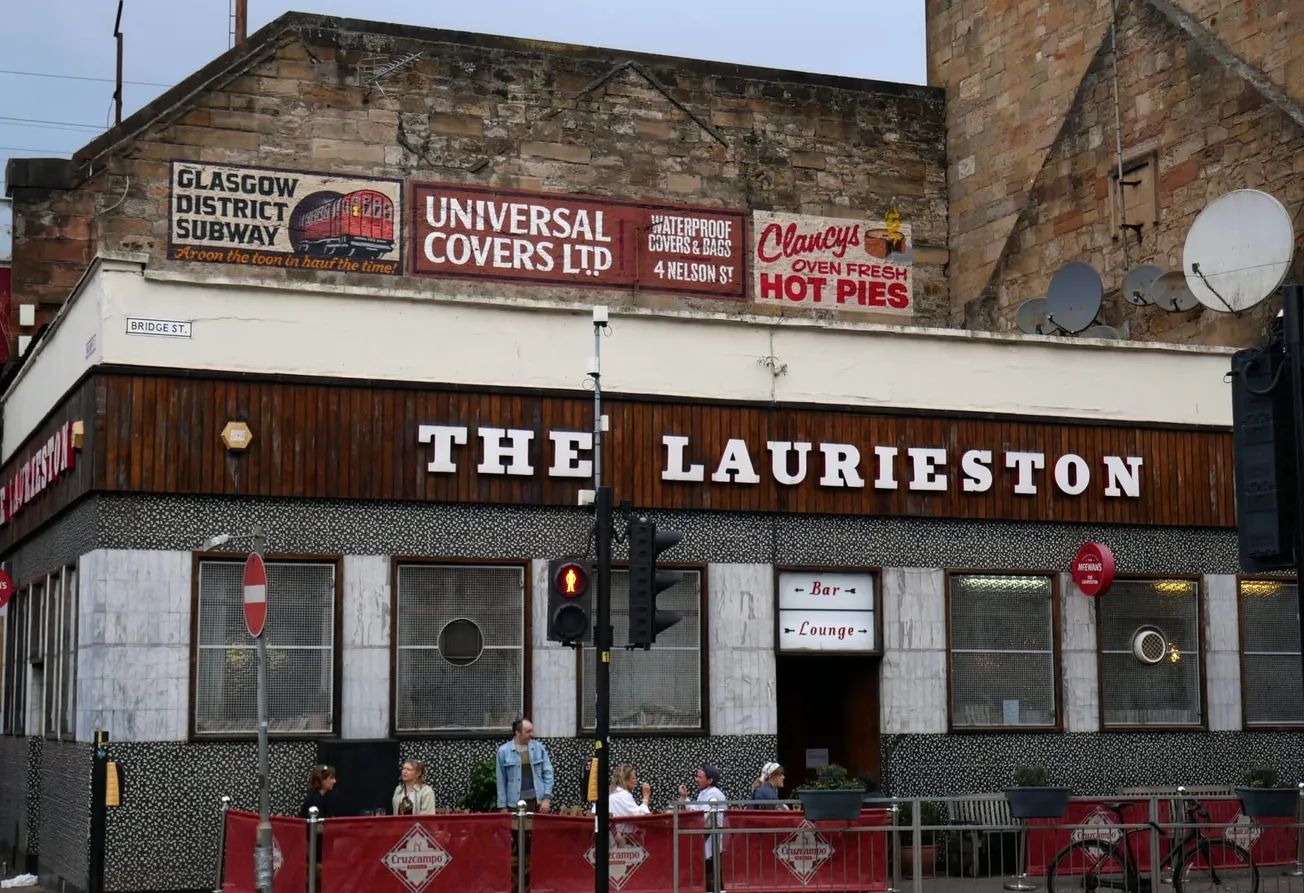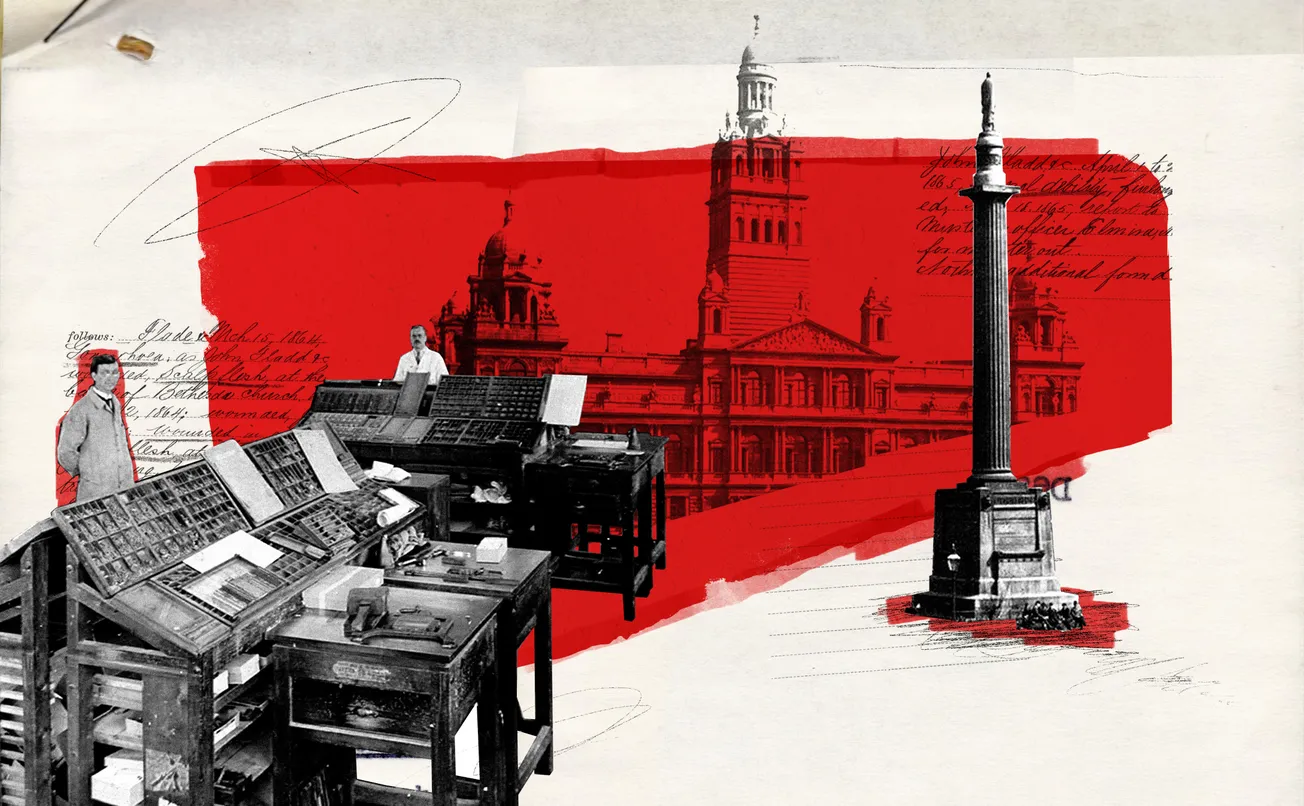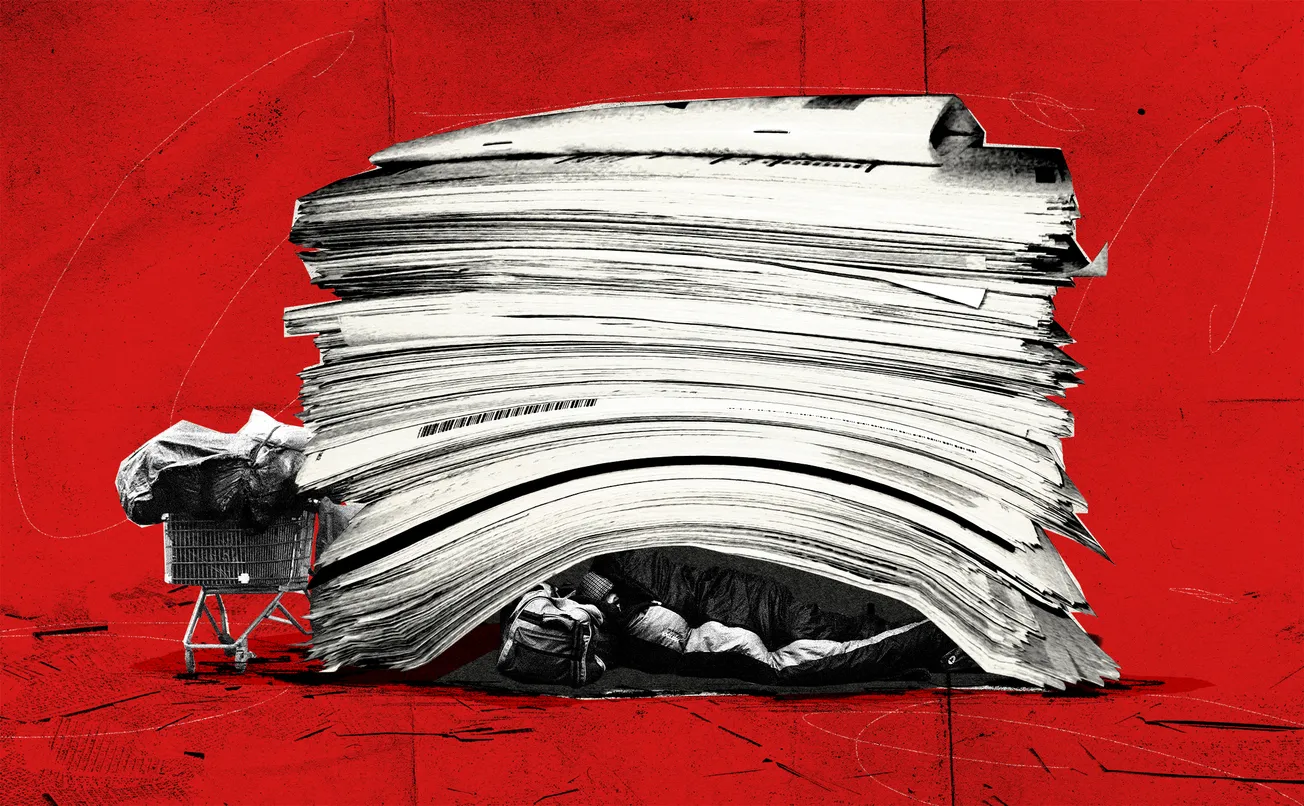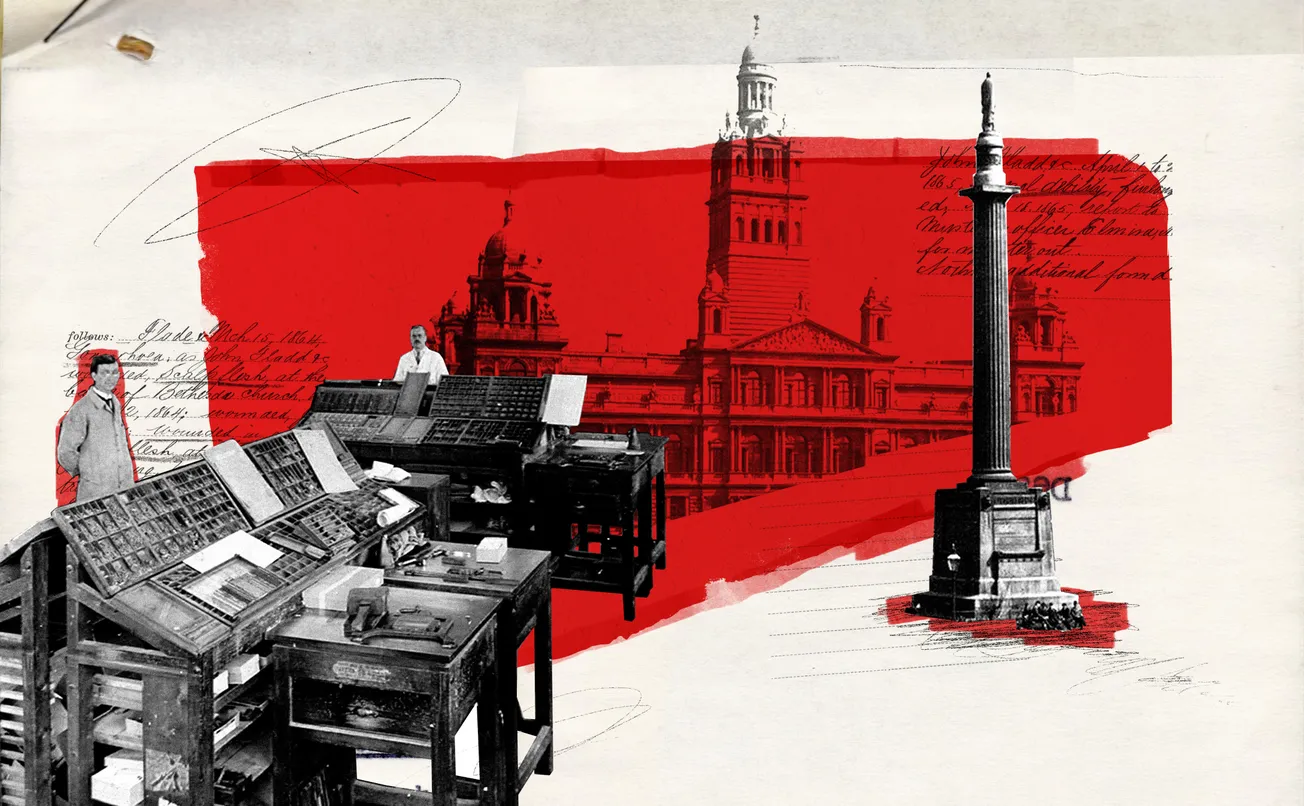“You’ll need tae speak as loud as humanly possible as I’m deaf in my left ear,” says Barny Taplin, the owner of Carlton Studios. He’s been running these music rehearsal rooms and cafe in North Laurieston for 35 years. “That doesn’t have anything to do with all the loud music does it?” I ask him. “Well, aye,” he concedes.
The 72 year-old is sitting with me in the basement of 54 Carlton Place, at the northwesternmost tip of the Gorbals or one of the southernmost parts of the city centre, depending how you look at things. The first two floors of this elegant Georgian townhouse are occupied by the studios, but the Grade-A listed Laurieston House next door has its neoclassical entrance boarded up. The townhouse’s sister building just west of here is in an even worse condition. “I think it’s pretty shameful,” says Taplin. The west end of Carlton Place has been brutalised: smashed windows, clear evidence of drug use, mysterious fires, and, crucially for him, the almost total emptiness of one of Glasgow’s crown jewel buildings. It once drove demand for eight dozen morning rolls a day from his cafe. Now, he’ll be “lucky to sell three dozen”.
Over the years, Taplin has seen residents and businesses leave North Laurieston in their droves. Meanwhile, nearby Gorbals tenement blocks were demolished and replaced with high quality housing, the Merchant City got cleaned up, and the Barclays Campus transformed the other side of the train tracks. Yet North Laurieston, despite its 33 listed buildings, cultural institutions, and an enviable city centre location, has missed out.
This has led to serious rot. In 2024 the India Buildings came down. There are gaps where once-great monuments to the city’s golden age stood. Locals speak of feeling unsafe due to a lack of street lights and all the vacant, graffitied plots.
But that might be about to change. “This should be one of the most exciting developments in the country,” Councillor Ruairi Kelly tells me over the phone as I sit on the steps of Laurieston House watching the overgrown southern edge of the Clyde. He’s talking about the North Laurieston Masterplan — a detailed roadmap designed to usher in a new era of pedestrian-friendly avenues, a mix of housing types, and making much more of the many architectural gems throughout.
In terms of specifics, the masterplan, which is produced by a joint venture between Glasgow City Council and the New Gorbals Housing Association, includes reducing traffic flow on Bridge Street; pedestrianisation and cycle paths in the area encircled by Bridge Street, Norfolk Street, Gorbals Street, and the Clyde; and fast-tracking development (private, council, or NGHA). Leafy planters will even line the paths, forming ‘rain gardens’.
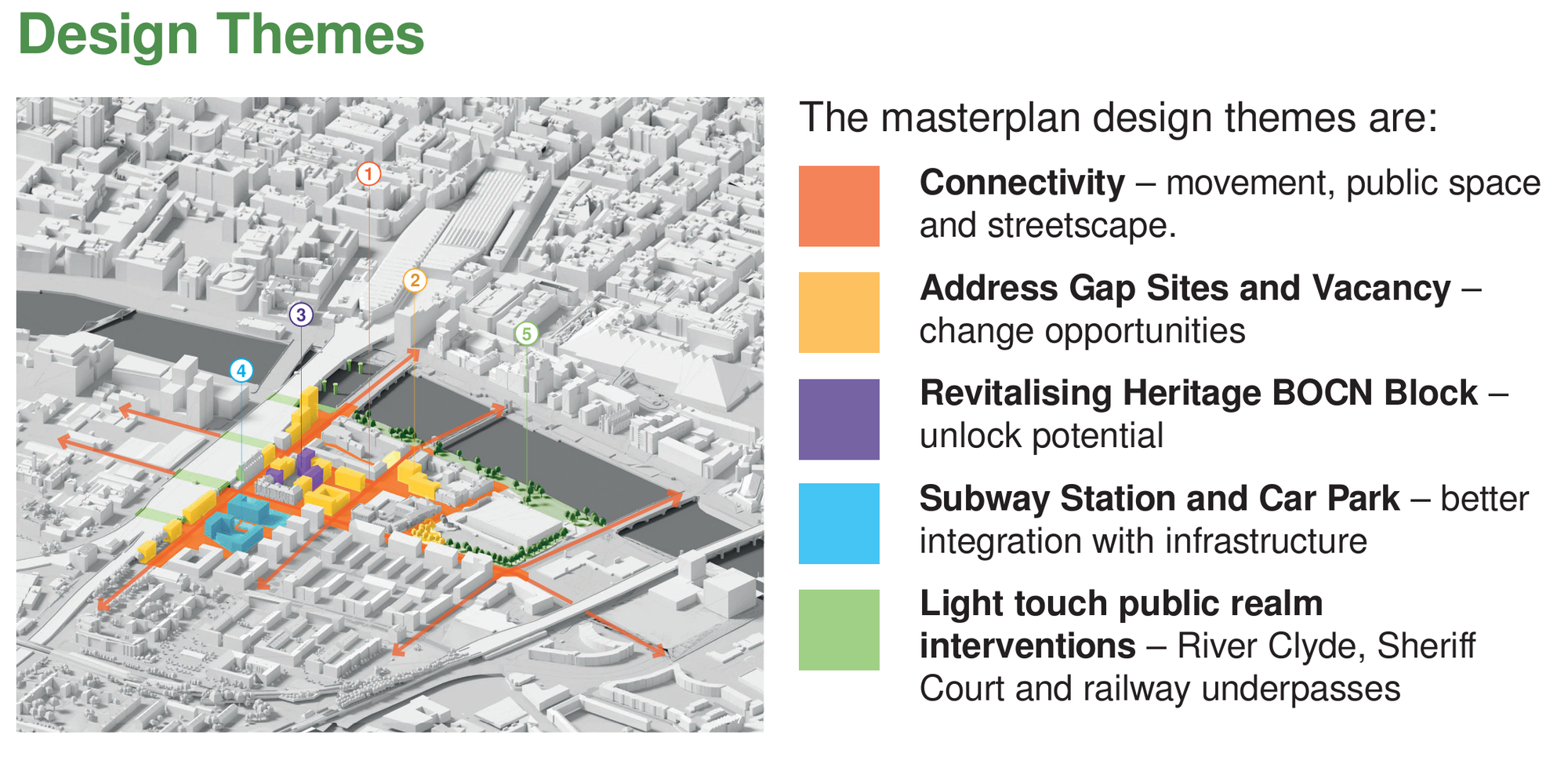
“Not to sound pretentious, but it could be Glasgow’s South Bank,” Kelly continues, referring to London’s 1950s transformation of a strip of derelict land by the Thames into one of the UK’s key cultural centres. It’s not hard to see how, if the plan succeeds in re-densifying the local population as well as harnessing the pre-existing cultural institutions, vibes à la South Bank could well be achieved.
To Cllr Kelly, this is North Laurieston’s moment. He and Bailie Dr Soryia Siddique have pushed for the Masterplan to be produced, bringing in New Gorbals Housing Association to lead the project. It’s in its first consultation phase, and Kelly and Siddique want local residents and businesses to get excited about it.
There’s a lot at stake. For North Laurieston has always provided an artery through which trade travels in and out of the city centre and south. With so many projects nearing completion around it, planners and politicians see its rebirth as essential to the city’s overall health. But what do the Lauriestonians think?
Welcome to The Bell. We're Glasgow's new quality newspaper, delivered via email. Join our free mailing list to get two full editions a week: a Monday briefing, full of things to do and bitesize news, straight from the dear green streets, and a weekend feature, taking you deep inside the bowels of Glasgow.
To get total access to all four of our weekly editions, you can join up as a paying member. We'd love that. But we understand you might want to try before you buy, so click below to sign up totally free and start getting our special brand of local journalism straight to your inbox today.
Tour de Laurieston
Nade Ali runs Namak Mandi, possibly Glasgow’s largest South Asian restaurant. He’s from the Khyber region of Pakistan, near to the Afghan border. Namak Mandi is an area in the ancient city of Peshawar; from where his family moved to Glasgow when he was eight and “couldn’t speak a word of English”.
He’s telling me this from the driver’s seat of his white Mitsubishi SUV as we go on a tour of Laurieston. He knows the place, having spent his formative years living above his family’s Spar shop on Bridge Street. “I’ve got a scar here, another scar here,” he says as he points to his temple. “It’s just what has happened in the area in the last 15 years I’ve been here.”
Ali knows these streets well and lets me in on some of their darker undercurrents. He paints a picture of entrenched criminality which exploits people and intimidates locals. If he was going to fix it, where would he start? “Street lights need to be a thing, they need to fix what’s broken first,” Ali states passionately. To him, grand plans to transform the area are pie in the sky when, he claims, bins aren’t being collected, buildings are literally collapsing around him, and assaults take place left, right and centre.

In 2017, his family set up the first Namak Mandi a few doors down. Then, in 2021, they bought 100 Norfolk Street, the former Gorbals Library, an imposing red sandstone structure which they’ve spent three years converting into a venue that can seat nearly 800 diners.
The Alis invested a lot of money into their enormous venue, and part of their new business model is hosting weddings and other extravagant events. He takes me to one of the building’s upper floors, decked out with table and chairs in clean white and light blue satins. There are white and gold chairs set out at one end of the room, presumably for photos with the bride and groom — there’s a wedding taking place here the next day. “Asian people have a thing, right? On their wedding day, they’ll bring out all sorts of cars,” he chuckles. Ali sees his customer’s ability to drive up to the doors of his restaurant and park nearby as crucial to its success. To him, pedestrianising the area would be a disaster.
But, in the Masterplan, this “car dominance” is one of the factors that has led to Laurieston’s decline. Streets are wide, with three to four lanes of traffic plus parked cars. The Kingston Bridge has slip roads that empty onto A-roads flowing straight into Laurieston. This creates a hostile environment to visitors and contributes to the area being somewhere you go through, rather than visit.
Fraser Stewart, director of New Gorbals Housing Association, tells me that some businesses’ dependence on cars can clash with what’s best for the area. The consultation process (of which the Masterplan is in its first stage) is there to “firstly listen and act on local residents’ and businesses’ concerns, but also be honest about the parameters within which this area has to be made to work”, he says. And two of those parameters “are stopping it being an on-ramp for Glasgow’s motorway network and not turning it into a car park”.
Laurieston is becoming an “embarrassment to the city”, Stewart continues, with its “concentration of listed buildings at risk of falling down like dominoes”. He’s referring to the India Buildings, which were demolished by the council after their roof collapsed in 2024. (The council still hasn’t recovered the £1m cost of the demolition from the owner.) That site is surrounded by other listed buildings, including 147 Oxford Street, which Stewart admits is in a terrible condition.
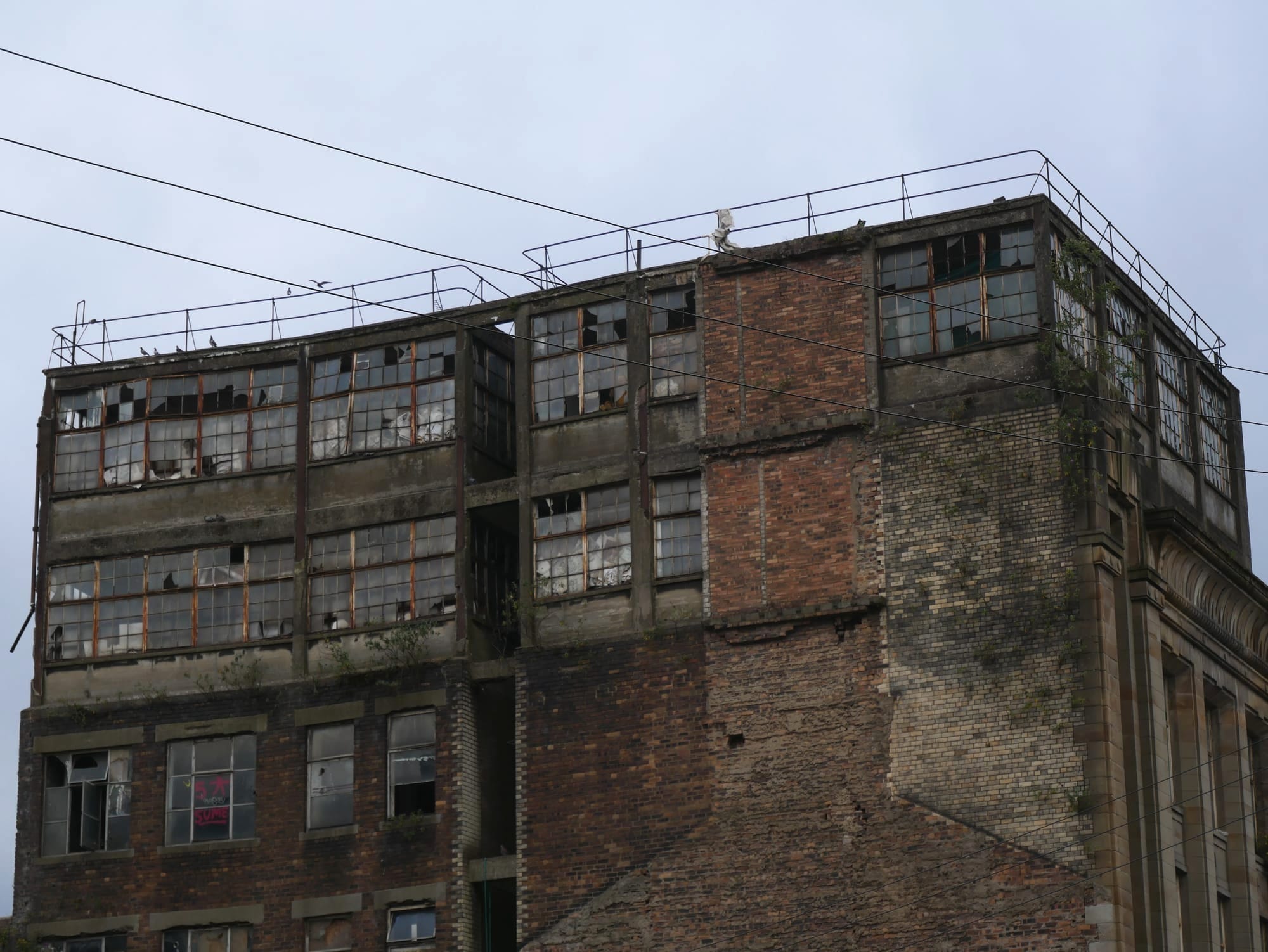
For any regeneration plan to work, the council will need to get a grip on the age-old Glasgow problem of rotting heritage and absent owners. But Stewart assures me that the council means business, otherwise his housing association would not have got involved. Cllr Kelly also promises action over the phone, saying he knows that “no one is going to spend 50–60 million on a building if the one next to it could literally collapse”. He adds that he wants to bring on board owners or otherwise use compulsory purchase orders in his role as city convener for neighbourhood services and assets. But in North Laurieston, Kelly faces the same opaque ownership structures and expensive legal processes that have undermined previous council efforts to protect such buildings.
New Gorbals Housing Association has a track record of delivering grand regeneration projects, as seen in the New Gorbals and Hutchesontown housing just to the south. These have added over 3,000 dwellings to the area, made up of part social and part private ownership. Now, Fraser Stewart believes, North Laurieston can complete the project. “It’s as much a part of the city centre as it is the Gorbals, so [Laurieston] becomes that bridge, that link.” Between the council, NGHA, and a desired private investment consortium, Kelly and Stewart believe this Masterplan will get off the ground and bring massive change to North Laurieston.
"Its bones are beautiful"
A lot of the language used in the Masterplan and discussions about it uses terms like “neglect”, “decline”, and “forgotten”. But I like the place, so I find that a bit sad. That language leaves out the contribution of recent immigration, of which Nade Ali’s family is a prime example, where incomers starting a fresh life in Glasgow have given Laurieston its current social clubs, restaurants, and shops. Without them the area really would be forgotten. Nor does that language reflect the genuinely vibrant community of artists that have moved here.
The nucleus of that community is in the defiantly beautiful and very pink Oxford House. Patricia Fleming, who opened her gallery here in 2023 after moving her archive over from the Merchant City in 2016, believes that the contemporary art scene in Glasgow is the best in the UK, and says that other studios and galleries have joined her in moving to Laurieston. “There are people coming here as part of a gallery circuit,” she tells me from her desk in the chic white-walled exhibition space. Fleming, whose over 30-year career of curating and organising art projects in Glasgow has led her all over the city, loves Laurieston and says its diversity is “more like a larger metropolis”. To Fleming, the area “doesn’t need radical change, its bones are beautiful”.

Fleming recalls when the Merchant City was also ‘no-go’, but then creative businesses helped begin its transformation, in a similar fashion to what might happen here in North Laurieston. But for now, she cautions, the area has been forgotten “at a civic level”. Like Ali, she’s referring to things like bin collections and street lights, with the latter’s absence contributing to real fear she and female colleagues feel as they navigate the closes at night. “But it has not been forgotten by the people who live and work here.”
When Fleming heard that the New Gorbals Housing Association was getting on board she had more faith that, this time, change was for real. But could that change lead to gentrification (something Nade Ali also brought up as being a concern)? North Laurieston is in the precarious position of needing investment but with a risk that the very people that make the area attractive (artists, strong migrant communities, and independent shops) are priced out as rents increase. That may be a long way off, but Fraser Stewart of NGHA is confident Laurieston will be spared the worst excesses. “If you add social housing to a significant extent in an area you limit the amount of gentrifying that can take place.”
Stewart points to the 1,250 social homes that NGHA have built in New Gorbals and Hutchesontown as shielding the area from soaring prices in the future. While North Laurieston itself isn’t ideal for large-scale housing, the Masterplan mentions “mixed-use” neighbourhoods, with Stewart reckoning it has space for a “couple of hundred” additional homes.
Fleming feels that Fraser Stewart and his team at NGHA have been good at understanding the area and that the “languages, arts, and culture are what makes this place special”. Laurieston clearly punches above its weight in art and culture, as Fleming lists off about five local galleries or exhibition spaces, not to mention the soon-to-reopen Citizen’s Theatre and the iconic O2 Academy.
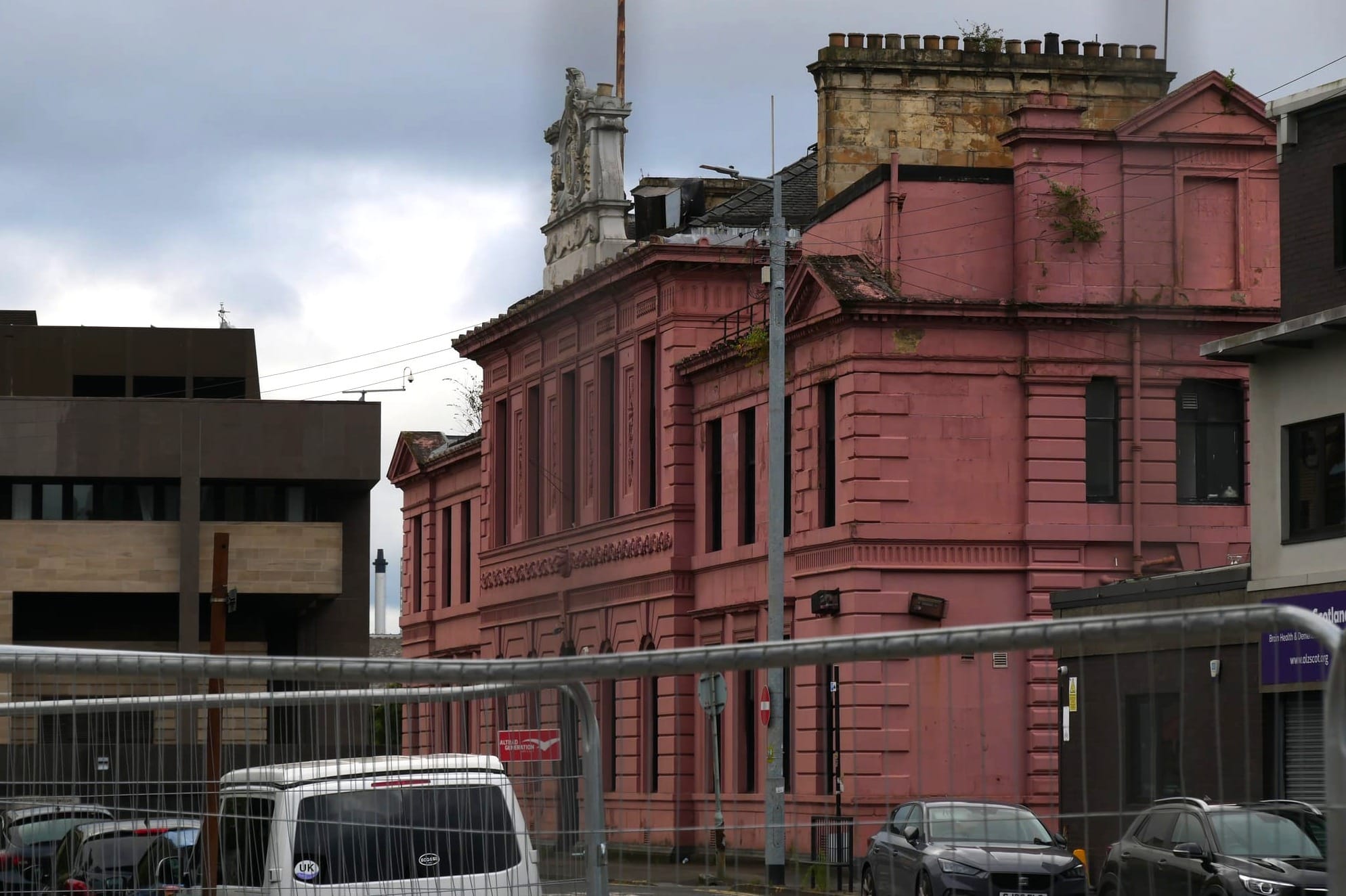
I leave the pink palace on Oxford Street and head out to take some photographs. I walk past The Laurieston and the Sou’wester, two pubs whose fates couldn’t be more different, yet both represent different sides of the area. The former is one of the city’s prized cultural assets, while the latter is a study in urban decay. Indeed, the derelict Sou’wester attaches onto a white tenement building that was compulsorily purchased by the council over unpaid debts and “alarming conditions” after it was being let out by someone who didn’t even own it.
As I’m snooping around with my camera to photograph the top of 147 Oxford Street to show how uneven it is, a man whistles to me from within a private car park at the base of the building. “The gate’s open, come in,” he says with a cigarette between his lips. The yard had a skip at the base of a whitish building with multiple layers of paint flaking off the bricks. His name is Shaz, and he and his dad own the building I’m looking up at, which was yet another listed neighbour of the doomed India Buildings. He wouldn’t sell it to the council (they own a lot of property in the area, it transpires). But he doesn’t see the masterplan as all that important — it’s tomorrow’s issue, something that if it does happen, won’t for a long time.
He invites me to touch the building’s white brick work. Initially confused, I reach out towards it, feeling my way along the white chipped paint until I find a patch of the material underneath. It’s cold and smooth with light grey swooshes. “It’s all marble," Shaz tells me, proudly. Patricia Fleming was right about Laurieston. Its bones are beautiful.
*This article was amended on 14.07.25 to reflect that New Gorbals Housing Association's involvement was at Hutchesontown, not Oatlands as was previously written.
What are your hopes and fears for North Laurieston? Let us know in the comments.
Comments
How to comment:
If you are already a member,
click here to sign in
and leave a comment.
If you aren't a member,
sign up here
to be able to leave a comment.
To add your photo, click here to create a profile on Gravatar.

